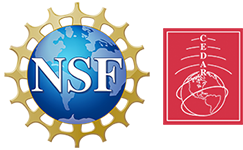2025 Workshop: HILAT-GAP
Dan Billett
Qingyu Zhu
Denny Oliveira
Andrew Pepper
Understanding high-latitude thermosphere dynamics is crucial for unraveling the complex role space weather has on the neutral atmosphere. Because the high-latitude thermosphere is coupled to the magnetosphere-ionosphere system via ion-neutral collisions, the neutral atmosphere experiences highly dynamic forcing during periods of elevated geomagnetic activity. This forcing, which leads to increased Joule heating and ion-neutral collisions, can rapidly alter neutral density, composition, temperature, and winds globally. These changes can lead to increased satellite drag, putting LEO satellites at risk of de-orbiting. The high-latitude thermosphere is uniquely positioned on the boundary of GEM and CEDAR, and its dynamics have impacts on research topics of both communities. For instance, high-latitude neutral winds can significantly change ionospheric currents, altering ground magnetic disturbances and resulting induced currents. The Joule heating rate, which can impact the initiation of traveling atmospheric and ionospheric disturbances (TADs/TIDs) into mid- and low-latitudes also depends on high-latitude neutral winds. Moreover, the thermospheric composition change can lead to significant changes in the magnetosphere-ionosphere-thermosphere system. Therefore, it is crucial to bring together the efforts of both GEM and CEDAR to highlight the current status of the field, identify open science questions, and discuss how to overcome obstacles in methodologies.
Previous research efforts of the high-latitude thermospheric dynamics have been limited due to a lack of global and continuous observations. Additionally, modeling efforts have difficulty characterizing the meso-scale high-latitude thermospheric dynamics due to their focus on resolving global, larger scale phenomena. However, several upcoming missions will provide much needed thermosphere and ionosphere measurements in order to address the open science questions. In addition to the upcoming GDC satellite mission, which will provide in-situ observations of the thermosphere, GDC-Ground will add 6 new Fabry-Perot Interferometers (FPIs) across North America. A new SDI array is also being installed in Scandinavia, which will provide three-dimensional measurements of the neutral wind inside a mutual volume with the EISCAT-3D measurements. These upcoming measurements can additionally be combined with modeling efforts to create a complete picture of high-latitude thermosphere dynamics.
This workshop will focus on studies of high-latitude thermosphere dynamics, including winds, composition, density and temperature, and their impacts on the MIT system during geomagnetically enhanced periods from both modeling and observational fronts. Scene setting talks will be utilized to introduce high-latitude thermosphere dynamics and their drivers. These dynamics will also be discussed in the context of GEM and CEDAR science objectives to establish a common ground between both communities. These talks will be followed by roundtable discussions. Through these roundtable discussions, the workshop aims to produce a comprehensive list of open science questions that can be addressed with the upcoming thermospheric measurements. Roundtable discussion will also address what additional measurements or model improvements are still needed. Finally, roundtable discussions will address how to build a more permanent collaboration between the GEM and CEDAR communities, including proposing a challenge event to combine the efforts of both communities in tackling the open science questions.
Thursday, June 26th, Ballroom B
10:00 - 10:10: Kylee Branning, University of Alaska Fairbanks, "Ground Based Optical Remote Sensing of Thermospheric Winds Resolved Over Four Dimensions"
10:10 - 10:20: James Clemmons, University of New Hampshire, "LLITED cubesat observations of the high-latitude thermosphere during geomagnetic activity"
10:20 - 10:30: Joon Kim, Boston University, "Investigation of Meso-Scale Thermospheric Neutral Winds using Multi-Instruments"
10:30 - 10:40: Yue Deng, University of Texas at Arlington, “Impacts of Neutral Wind Dynamo on the Magnetospheric Configuration: MHD-GCM Coupled Simulation for May 2024 Storm”
10:40 - 10:50: Wenbin Wang, High Altitude Observatory, "Thermospheric perturbations from high-to low latitudes during the May 11, 2024 storm"
10:50 - 11:00: Qian Wu, High Altitude Observatory, "High latitude conjugate thermospheric wind observations and comparison with simulations"
11:00 - 11:10: Kristina Lynch, Dartmouth College, "Gemini, Magic, Gneiss, and Swarm-over-Poker all want neutral wind input"
11:10 - 11:20: Emma Spanswick, University of Calgary, Modern sensing of continuum emissions
11:20 - 11:30: Hyunju Connor, Goddard Space Flight Center, “Terrestrial exosphere variability and its impact on magnetosphere – ionosphere – thermosphere coupling”
11:30 - 11:40: Onyinye Nwankwo, University of Michigan, "Role of Viscosity on High-Latitude Thermospheric Winds and Temperatures During Geomagnetic Storms"
11:40 - 12:00: Open Discussion
Virtual Information:
Topic: HILAT-GAP
Time: Jun 26, 2025 11:00 AM Central Time (US and Canada)
Join Zoom Meeting
https://bostonu.zoom.us/j/97147053902?pwd=HA9qh6YMSvxxwRr7KRKmH0uZOLib57.1
Meeting ID: 971 4705 3902
Passcode: 944524
The high-latitude thermosphere is the boundary region between space and Earth’s atmosphere and it is therefore crucial to understand its dynamics during geomagnetically active periods. This region of geospace is also the boundary between GEM and CEDAR communities, and this workshop plans to utilize the joint GEM/CEDAR workshop to address the open science questions from the perspectives of both communities. The open science questions include but are not limited to:
How does the high-latitude thermosphere respond to varying scales of geomagnetic forcing?
What impacts do high-latitude thermosphere dynamics have on space weather effects?
How do high-latitude thermosphere dynamics contribute to the storm-time magnetosphere-ionosphere-thermosphere variations?
What observations or modeling efforts are needed to advance studies of high-latitude thermosphere dynamics?
How can the GEM and CEDAR communities prepare for new measurements, and what science questions can be addressed with these measurements?
Additionally, this workshop aims to bridge the gap between GEM and CEDAR and establish permanent collaborations between the two communities. These efforts are timely as the community prepares for the launch of GDC and will be necessary to support its scientific goals.
MPEC - Doğacan Öztürk
